Running is popular in New Zealand and can become quite addictive. But running isn’t just good for the heart - read on to discover some of its other fantastic benefits. Then, grab your running shoes and head out into the fresh air!
So, get out there and enjoy the myriad benefits that running has to offer!
Whether short on cash or you simply just don't want to have to fork out everytime you go out as a family, there are always lots of free or fun things to do including -
Get the bikes out and go for a family bike ride. A quick lap around the neighborhood or park can be fun, if you're looking for local walks and cycles check our Hibiscus Coast Walks and Cycleways page or looking further afield around Auckland check out the Auckland Council Wheely Good Time Family Fun article.
Make a list of free museums and attractions in your area. Then work your way through the list until you've visited them all. Art museums, history museums, monuments-there's sure to be something worth checking out at each one. Locally a couple of great options to visit are the Silverdale Pioneer Village, Warkworth Museum and Bohemian Settlers Museum in Puhoi.
A great source for free books, movies and magazines, and it can also be a good source for other types of free entertainment. Check with your library to see if there are any upcoming story hours, concerts or educational programs that may be of interest to your family. Then be sure to take advantage of them. We have two great libraries here on the Coast and you can find details and information on our Linku2 Libraries page. (Please note at July 2024 the Orewa library is currently closed for renovation, library services are being offered out of the Orewa CAB).
Head out after dark for a night of stargazing fun. You can use a telescope and an astronomy guide to help you locate the constellations and planets or just wing it as you stretch out on a big blanket and stare at the sky. Either way, the evening promises to be as enjoyable as it is educational.
Play a few shorter games or one long one. Eitherway add a bit of spice by having prizes for the winners!
Add in some personalised charades - make one up each and get the others to act out - there are plenty of charade ideas on the internet too if you get stuck for ideas.

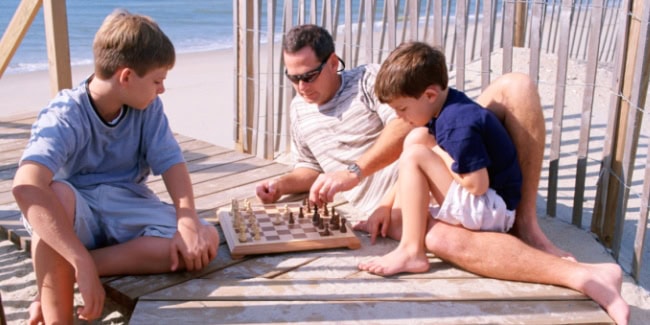
Depending on the time of year fruit picking may not be available. Head out catch a fish, pick some fruit and then back at home make something with your fresh produce! Whilst there are no local options there are a number of opportunities you will find in West and South Auckland so head out and make a day of it (check the picking season though!).
Cooking is an important life skill, and it can be a lot of fun to teach. Pick out an interesting cookbook and each pick a dish to make up a full meal - help each other with the courses and then sit down for a sumptuous but potentially unusual or unexpected meal!
Camping is the ultimate family adventure. Grab a tent, some sleeping bags and torch and head down the garden for a fun, family bonding night. You can sing camp songs, tell ghost stories, nibble on snacks and play games all without leaving home. We have lots of local options including Shakespear Regional Park, other nearby regional parks and an excellent campsite on the water's edge in Orewa.
Don't just pick the movies together but prepare together. Pop the popcorn, make up lolly bags, rearrange the room with pillows and cushions and set the stage for a fun family time.
These are just a few suggestions - there are so many things you can do together but just make sure you find the time to do them all!
Let us know in the comments below you're favourite family activity and any new ones we can add to this post! Thanks!
The Abel Tasman Coast Track is located in Abel Tasman National Park on the northern shores of South Island. This 54.4 km track features all streams bridged, but there are tidal crossings that can only be navigated within a few hours on either side of low tide. The track typically takes three to five days to complete and can be walked from either end. There are huts and campsites along the way, available for a fee, and bookings are required. There is no charge for day walks. Visitors can enter the park from roadend carparks, take water taxis to beaches along the track, or kayak along the coast.
The nearest towns of Nelson, Motueka, and Takaka offer all amenities you will need and Kaiteriteri has a petrol station, a small grocery shop, accommodation, and a café. Marahau also offers accommodation, a shop, and cafés. Note that Takaka is the last place for petrol before reaching Totaranui.
The track runs from Marahau in the south to Wainui in the north.

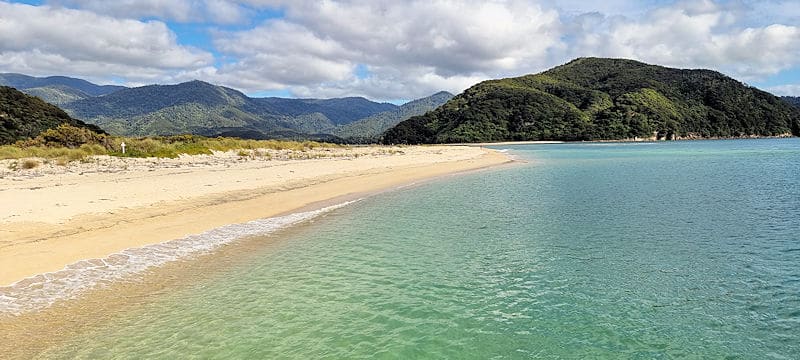
Starting at Marahau, the track passes through open countryside to Tinline Bay, then through beech forest with large kanuka trees, turning inland through several gullies. It offers views over Torrent Bay and the coast and islands to the north. Anchorage Bay has a hut and campsite.
Continuing north, the Torrent Bay estuary can only be crossed at low tide, though there is a high tide track around it. The track climbs steadily from Torrent Bay, passing above two valleys and crossing Falls River on a 47 m suspension bridge. It then descends through coastal forest to Bark Bay, which also has a hut and campsite.
After crossing the Bark Bay estuary, the track passes through manuka stands and along the shore past remnants of a granite quarry at Tonga Quarry. Onetahuti Bay can only be crossed within three hours on either side of low tide. The track then climbs over Tonga Saddle and descends to Awaroa Inlet, which has a hut and campsite.
The Awaroa estuary can only be crossed at low tide. The track then climbs over a low saddle, descends to Waiharakere Bay, and continues through forest to Goat Bay. From there, it climbs to a lookout above Skinner Point before descending to Totaranui.
The track heads around the Totaranui estuary, climbs over a low saddle, and winds down through lush forest to Anapai Bay. From Anapai Bay to Mutton Cove, it passes through sandy beaches and rocky headlands of regenerating kanuka. The track then climbs to another saddle and descends to Whariwharangi Bay. From here, it follows a small stream, climbs to a saddle overlooking Wainui Inlet, and winds down to the shore, following the estuary edge to the carpark.
Extract abridged from track description at www.doc.govt.nz
For many visitors to Africa, the primary attraction is the wildlife. No other continent offers such diverse and close-up viewing opportunities. Learning about the animals you may encounter can greatly enhance your experience.
Most safari-goers in Africa aim to see the "Big 5": Lion, Leopard, Elephant, Buffalo, and Rhino. However, Africa is home to far more than these five species, with over 1,100 different mammals and more than 2,600 species of birds.
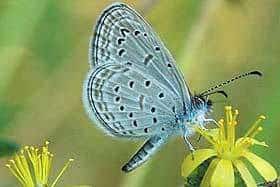


Facts courtesy of www.africaguide.com. For more information on Africa, please visit their website.
There are so many options for delicious smoothies – here are just a few ideas …
This tropical-tasting smoothie is going to make you feel like you're on an island vacation soaking up the sun--even if you’re stuck in rush hour traffic on the interstate. This recipe calls for frozen fruit, making it a cinch to prepare in
Ingredients
Preparation
Place 2/3 cup frozen sliced peaches, 2/3 cup frozen mango pieces, 2/3 cup peach nectar, 1 tablespoon honey, and 1 (6-ounce) carton organic peach fat-free yogurt in a blender; process 2 minutes or until smooth. Serve immediately.
Frozen banana gives this pumpkin smoothie a thick texture; chilling the pumpkin ensures the smoothie stays cold when you blend it. Add in yogurt and orange juice and you have a breakfast beverage with 740 milligrams of potassium per serving.
Ingredients
Preparation
Combine yogurt and next 8 ingredients (through banana) in a blender, and process until smooth. Garnish with dash of ground cinnamon, if desired. Serve immediately.


A frappé is similar to a fruit juice or other liquid smoothie, but it's made with a larger proportion of fruit than dairy. Garnish with a twist of orange zest, if desired. To skip the dairy, substitute vanilla cultured coconut milk for the low-fat yogurt.
Ingredients
Preparation
Combine all ingredients in a blender; cover and process until smooth. Serve immediately.
Peanut butter and banana smoothies are usually a splurge item. Luckily, we have a healthy version that doesn't skimp on flavor. If the smoothies seem too thick, add another tablespoon or two of milk.
Ingredients
Preparation
Place all ingredients in a blender; process until smooth.
Desynchronosis, commonly known as jet lag, is almost inevitable after a long-haul flight lasting more than 10 or 12 hours. Despite various remedies on the market, there is no quick fix for this chronobiological condition; your body needs time to readjust.
Humans are biologically designed for slower forms of travel, like walking or horseback riding. The rapid pace of modern flight can disrupt the body's internal clock, which regulates eating and sleeping patterns. This disruption can last for about a week after a long flight, making it harder to adjust to a new time zone.
Jet lag typically occurs when you cross three or more time zones, which can significantly affect your biological rhythms. Melatonin, a hormone produced in the dark, causes drowsiness. Until your melatonin levels adjust to the new time zone, your sleep patterns will be out of sync.
Severe jet lag can cause:
Jet lag can also disrupt your digestive system, making regular meals less enjoyable and harder to digest. Furthermore, since the body often performs internal maintenance during sleep, jet lag can weaken the immune system, making you more susceptible to illness.


While no magic cure exists, you can take steps to reduce recovery time:
The time needed to recover from jet lag varies based on age, physical fitness, and genetics. Generally, allow one day for each time zone crossed. The direction of travel also matter. If traveling west, divide the number of time zones crossed by two; if traveling east, expect a recovery time of about two-thirds the number of time zones crossed.
For some standing out is important and others run for the hills, not for everyone.
Standing out in business is different. For the majority getting noticed is a key priority. But yelling things people have heard before won’t get through. They’re tired of hearing it and switch off. People want stories that make them change the way they think, true ones are most engaging. Businesses that say and do real things no one else can will get people talking.
In this busy world it's hard to stand out and therefore hard to get noticed but it is essential for you to be recognised to be found in the right places and to make sure you tell your potential customers what is your USP (Unique Selling Point).
Read more on how you can define your USP and if you want help in either identifying it or, once identified, how to then translate this into, and across, all your branding platforms so customers know exactly who you are and what you offer them call Chris at AllBrand who can help you take your business to the next level.
If you'd also like support with different issues you have in your business and don't have any, or many, sounding boards why not head along to a meeting of The Independent Board - Fresh Thinking, a group of small business owners, who work together on solving business issues!
If you're worried about getting locked out of your house or car, here are some tips and tricks to help you avoid that situation.
Home lockouts can be frustrating and distressing, but they are common. Fortunately, there are several things you can do to help avoid being locked out of your home.
By following these tips and suggestions, you can significantly reduce the chances of experiencing a lockout and ensure that you always have access to both your house and your car. However, if you do find yourself in that situation, the local professional to call is Jason from King Locksmiths.
King Locksmiths, 34 Bay Vista Drive, Red Beach, Whangaparaoa
0800-55-79-79 - jason@kinglocksmiths.co.nz - https://kinglocksmiths.co.nz
Hearing losses usually develop very slowly, so it is easy to not notice them creeping up on you. If you are concerned about your own hearing, or that of a loved one, you can run a self check to give you some ideas. Hear Again, in Whangaparaoa, have an online self-check test, you are welcome to run through.
If you determin that perhaps hearing is affected but it may not actually be hearing loss it may be a case of blocked ears. Did you know approximately 5% of adults and 10% of children deal with blocked ears at any one time! If you’re uncertain whether ear wax is causing your hearing issue or whether an ear wax removal service can help, drop into Hear Again and their experienced staff will take a quick look free of charge. Ear wax removal is quite a simple and painless procedure and you can read more about what causes it and ear wax removal online with Hear Again.
Another frustration you, or a loved one, may experience is that annoying ringing in your ears! So what is it?
Tinnitus is the sensation of hearing sounds that aren't present in the external environment. It can manifest as ringing, buzzing, hissing, whistling, throbbing, booming, clicking, roaring, or a cicada-like noise. Tinnitus may consist of a single sound or multiple different sounds, and it can develop gradually or suddenly.
This condition is quite common, with most people experiencing it at some point, especially in quiet surroundings. About 20% of the population experiences persistent tinnitus, and for 4%, it significantly affects their quality of life.
Read more on what tinnitus is and how it can be combatted.
If you need support or hear advice remember Hear Again offer free hearing tests and also operate an in-home service if it's hard to get to their Whangaparaoa premises. The team are always happy to advise and help so you can "Rejoin the Conversation"!
Hear Again, Coast Whangaparaoa, 6 Main Road, Stanmore Bay, Whangaparaoa
0508-432-724 - info@hearagain.co.nz - https://hearagain.co.nz
Funerals play a very important role in helping us to cope with our grief. They are for the living – they provide us with an opportunity to say our goodbyes, to be with people to give and receive support and to reflect and share the memories of the life of someone we have lost that mattered to us.
When someone we love dies, the funeral is not for them, it’s about them. The funeral is for everyone who knew, loved and was connected to that person.
Read more on why funerals are so important from Forrest Funeral Services.
It is also important to pre-plan for your own funeral. This helps not only for your funeral to be as you would have wished but can also take away some of the stress behind organising the funeral for those who have been tasked with this job after you have passed away. Forrest Funerals can provide you with a funeral pack to guide you along the way and remind you of what will be needed.
You can also download a Funeral Checklist to ensure you don't forget any important details.
You can also record your choices of readings, music, pallbearers, flowers, etc. You can either complete a copy of the form online or download a form which you can then give to Forrest Funerals.
It can be quite daunting thinking about a funeral, whether yours or that of a loved one, but comfort and peace of mind can come from knowing what to expect but Forrest Funeral Services offer links and articles on the above and other questions including writing a Euology, embalming, burial or cremation, venue and catering and many other topics.
Forrest Funeral Services, 39 Riverside Road, Orewa (also in Browns Bay)
09-426-7950 - llittle@forrests.co.nz - https://forrests.co.nz
Lending is seeing a lot of changes currently so here's a breakdown of what to expect.
Currently a bank can only lend up to 15% of its money to owner occupiers with less than a 20% deposit. As of July 1st this rises to 20% so expect more first homes buyers to be able to enter the market, good news for them!
Investors also have some good news, their deposit requirement drops from 35% to 30%, also on July 1st.
These are finally in force as of July 1st and the Reserve Bank sets them at 6 times income for home owners and 7 times for investors. Banks have up to 20% leeway as well so there can be exceptions. With current test rates these DTI's are unlikely to have any impact on how much you can borrow and our calculations indicate they only come into play when interest rates drop to below 5%.
This is now back in play at 80% of the previous amount and goes to 100% in 2025. This means that property investors can claim the interest on their investment mortgages. At the present time this is significant as holding costs for investors are detering many from investing causing a shortage of rental property and so a rise in rents. The average rent across the Country is now over $600 per week, a direct result of investors pulling out of the market in recent times.
The biggie for most of us. The Reserve Bank (RBNZ) is focused on getting inflation under control and their main weapon is keeping interest rates high. Lenders on the other hand are trying to get rates down to stimulate the mortgage market. We have never seen such a 'tug of war' between RBNZ and the market and our view is that the market will start to win in late 2024 and make greater gains in 2025.
We have not seen the impact of this as yet. However with over 130,000 net gain to our population it's only a matter of time and this is perhaps the biggest potential boost to the rental sector. Few of the new migrants will purchase themselves, however they need to live somewhere to live and for most the only option is the private rental market.
ComCom as it's called released a draft report into New Zealand's banking system and its distribution channels. It also made comments around the mortgage Adviser distribution. This part of the report caused outrage within the mortgage Adviser industry and ComCom have been forced to apologise and revise their thought process and report. The fact is that in New Zealand over 60% of bank mortgages are arranged via Advisers whilst in Australia it's over 70%. The main focus of the report however revolves around making it easier to switch banks and products which is a good thing.
Whether you are looking for the first time or refixing or expanding your portfolio it's really important to engage with an Adviser. Why? For starters your own bank will only advise about their products, which may well be the most suitable, but they may not be. Lenders vary significantly in how they assess incomes and debt, there is no one size fits all. When refixing these-days the banks ask you to do it via an App or online. There is no advice process here and many Clients have complained that they need advice and should have it. By going through an Adviser that advice is tailored to your specific needs.
As always we at iLender are here to help, read some of our 425 or so online reviews, we really do make a difference.
Article provided by:
Jeff Royle, Financial Paramedic, jeff@ilender.co.nz
Mobile 021 765 016 | Phone: 0800 536 337, www.ilender.co.nz
When buying a property that you plan to rent out, or if you are a tenant moving in to a new property do you know if it complies with the Healthy Homes Standards and if you're not sure do you know final compliance deadlines?
The healthy homes standards seek to bridge the quality disparity between rental properties and owner-occupied homes, ensuring that the approximately 600,000 renting households in New Zealand can enjoy cozier, drier living conditions.
Regarding the standards: The Residential Tenancies (Healthy Homes Standards) Regulations 2019 came into effect on July 1, 2019, with the objective of tackling issues related to coldness, moisture, drainage problems, and drafts in rental properties. These regulations establish baseline criteria for:
All rental homes need to comply with the Healthy Homes Standards by 1 July 2025 and up to that date landlords have 120 days from any new tenancy to comply.
So who can help you check if the property you are looking at reaches the standards?
If you're on the Hibiscus Coast or North Shore we recommend a qualified building inspector and Healthy Homes inspector in Phil Yang from A Buyer's Choice.
With 15 years of experience in the construction industry, Phil has cultivated a keen interest in home inspection during his extensive career. This deep-seated passion has been a driving force behind his decision to transition into the home inspection sector.
Phil has earned full certification as a building inspector by successfully completing examinations administered by AHIT and InterNACHI, showcasing his commitment to professional development and expertise in the field.
The heating standard underwent revisions in May 2022 to account for the improved thermal performance of new homes constructed or renovated according to the 2008 building code requirements for insulation and glazing, as well as certain apartments. These changes imply that smaller heaters are generally adequate to maintain the required warmth in such types of dwellings.
To determine the appropriate heater size, landlords can utilize the heating assessment tool provided by Tenancy Services.
To meet the heating standard, landlords must furnish one or more fixed heaters capable of directly heating the primary living space in a rental property. These heaters cannot be open fires or unflued gas heaters; they must be permanently installed and not portable.
Acceptable heaters typically include heat pumps (if equipped with a thermostat), wood burners, pellet burners, or flued gas heaters. In specific cases, such as small apartments, a smaller fixed electric heater may suffice.
Ceiling and underfloor insulation are obligatory in all rental homes where it is feasible to install them.
The healthy homes standards categorize New Zealand into three climate zones, each with distinct insulation requirements. You can find information about these zones on Tenancy Services.
Insulation standards are measured by the R-value, indicating how effectively insulation resists heat flow. Higher R-values represent better insulation, and this value will be clearly displayed on the product packaging.
Any newly constructed or renovated property that complies with the updated 2021 Building Code insulation requirements will also meet the healthy homes insulation standard. Landlords who installed new insulation since July 1, 2016, and have it in good condition are likely to already meet the healthy homes standard.
Tenancy Services offers an online tool to help landlords determine whether they need to upgrade or replace their insulation to meet the healthy homes standard.
Inadequate ventilation can lead to mold and dampness issues, posing health risks to tenants and property damage to landlords.
To address mold and dampness stemming from poor ventilation, rental homes must have operable windows in the living room, dining room, kitchen, and bedrooms. Additionally, kitchens and bathrooms must be equipped with extractor fans.
The ventilation standard was updated in May 2022 to permit the use of continuous mechanical ventilation systems that exhaust air outside from kitchens and bathrooms, provided the ventilation system received building consent on or after November 1, 2019.
Moisture Ingress and Drainage: Moisture can be a significant source of dampness in a residence, leading to health concerns for tenants and property damage.
Rental properties must possess effective drainage systems for managing stormwater, surface water, and groundwater. In cases where a rental property features an enclosed sub-floor space, landlords must install a ground moisture barrier if it is feasible to do so. If installing a ground moisture barrier is not possible, landlords are not required to install alternative moisture barriers.
Addressing draughts can help reduce heating expenses for tenants and maintain comfortable living conditions in rental properties.
Landlords must ensure that their properties do not contain excessive gaps or openings in walls, ceilings, windows, skylights, floors, and doors that result in noticeable draughts. Additionally, all disused open fireplaces must be sealed off or their chimneys blocked to prevent draughts.
Landlords who fail to meet their obligations under the healthy homes standards are in violation of the Residential Tenancies Act 1986 and may be subject to exemplary damages of up to $7,200.
Most new or renewed tenancy agreements are required to include a compliance statement containing specific information about the rental property's current level of compliance with the healthy homes standards.
Private landlords who initiated or renewed tenancies between July 1, 2021, and August 27, 2022, must ensure their rental properties meet the healthy homes standards within 90 days of any new or renewed tenancy. Private landlords who commence or renew tenancies on or after August 28, 2022, must ensure compliance within 120 days of any new or renewed tenancy.
Kāinga Ora and registered Community Housing Providers have until July 1, 2024, to comply, while all private rentals must comply by July 1, 2025.
In 2020, surveys of renters and landlords were commissioned to assist HUD and the Ministry of Business, Innovation, and Employment (MBIE) in monitoring the implementation of the Healthy Homes Guarantee Act (HHGA). These surveys aim to track awareness of and compliance with the healthy homes standards through annual online surveys of renters and landlords nationwide.
For more information on the Healthy Homes Standards and tools please visit the Tenancy Services website or give Phil a call on 021 0286 6368 or email him at phil.yang@abuyerschoice.co.nz to get started on ensuring your proposed property complies with the Healthy Homes Standards.

The start of preschool is a significant milestone, often met with a blend of excitement, joy, and some inevitable tears and uncertainty from both children and parents! Preschool is designed to ease the transition from family life or a childcare center to school. These programs help develop children's communication, problem-solving, and thinking skills while familiarizing them with school routines and rhythms.
Talk About Preschool: Discuss with your child the exciting adventure that preschool will be. Speak with their future teacher and principal to gather detailed information about daily activities, bathroom routines, and meal times. This will help you address any questions your child might have, easing their concerns.
Plan a Celebratory Breakfast: Make the morning special with a celebratory breakfast and a small gift, like a new bag or a Starting Preschool Certificate. This can help your child feel important and excited about their new role.
Tip 1: Don’t Rush Through the Morning
A rushed morning is stressful for everyone, especially on the first day. Wake up early enough to enjoy a calm, unhurried breakfast, which helps avoid last-minute tantrums and ensures you arrive on time.
Tip 2: Arrive Early
Arriving early gives your child time to settle in before the crowd arrives. This also provides extra face time with the teacher, offering additional reassurance.
Tip 3: Bring a Comfort Object
If allowed, let your child bring a favorite stuffed animal or blanket. This can make the new environment feel less intimidating. As they become more comfortable, they can gradually leave the comfort object in their cubby.
Tip 4: Put on a Happy Face
Even if you’re anxious, try to stay positive. Your child will pick up on your mood, so if you seem confident and upbeat, they’re more likely to feel the same way.
Tip 5: Hang Around, But Don’t Hover
Many preschools encourage parents to stay for part of the first few days. If possible, stick around to give your child the courage to explore. Gradually step back as they become more secure, letting the teacher take over.
Tip 6: Keep Goodbyes Short and Sweet
When it’s time to leave, keep your good-byes brief and positive. Smile, give a hug, and let your child know when you’ll be back (“I’ll pick you up after lunch”). Avoid sneaking out, as this can make your child feel insecure.
Remember, it’s normal for kids to have a meltdown when separating. Even if your child is upset, they’ll likely calm down shortly after you leave. If the adjustment takes longer, don’t worry - preschool teachers are experienced in handling these situations. And don’t be surprised if your child is too happy and busy to let you know everything they've been doing when you pick them up!
If you're looking for quality childcare on the Hibiscus Coast make sure you check out Fame, where your children grow and learn with confidence!
Teaching your baby to swim might help them overcome their initial fear of water and provide a great excuse to have some fun and exercise at the same time, but it could have other benefits as well.
Recently, researchers from Norway and Britain found that children who had taken baby swimming classes did better on tests involving gripping and reaching as well as balance, compared to children who had no experience swimming as babies. This helps their physical progress later in life as well, along with providing them with some essential social skills.
All babies have primitive and postural reflexes, one of which is the Mammalian Diving Reflex, which is strong between 0-6 months. The Mammalian Diving Reflex is most well developed in children, and is gradually decreased with age. It enables them to naturally breath-hold when submerged, and this can be seen quite clearly when you plunge your baby into the water during a swimming lesson or in the family pool. When baby’s face enters the water covering their forehead and nose area; the body automatically redistributes the blood flow ensuring the 'key' organs such as the brain and heart, receive a constant supply of oxygen.
This reflex is perfectly natural and leaves around eight months of age. Gradually this reflex turns into the 'Dive Response', which continues into adulthood. As your baby is only submerged for a matter of seconds during a lesson, it is the 'Dive Response' that then kicks in and helps them as they learn to swim. Swimming lessons will ensure that they are comfortable with this reflex, and see them becoming happier and more confident in the water.
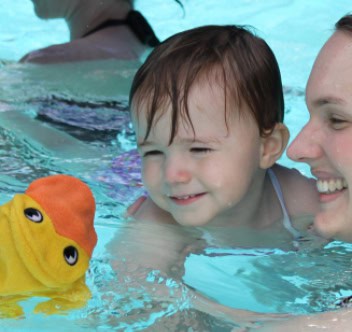
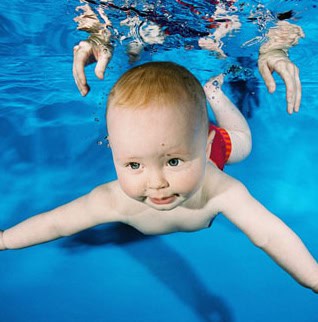
Gross and fine motor skills are also strengthened and coordination and balance are enhanced in babies who enter the water early. For this reason the younger your little one starts in lessons the easier the transition is to enjoying the water. A baby who is used to being stationary can move about independently in the pool as they learn balance and coordination. The motion and sensation of the water gives them an awareness of self that otherwise would not be gained at such a young age, and sets them up for life.
Additionally, early experiences in water allow little ones to better develop their psychomotor skills, because there they can move more freely and begin to understand concepts of distance and movement. Their cardio-respiratory system is also strengthened as the baby exercises his or her heart and lungs.
On the whole, a child who starts lessons early is far more relaxed and happy in the water, and in a country as water loving as New Zealand this is vital.
Based in Silverdale, Northern Arena has four cutting-edge, heated pools – all indoors. The pools are treated by ultra violet light similar to the way drinking water is treated, allowing for a low level of chlorine that makes them ideal for babies and those with sensitive skin. All of their lessons are designed to be fun as well as educational, enhancing enjoyment and confidence in the water.
Have a think about popping your child in the water whatever the time of year – you’ll be helping them on the way to knowing how to save themselves in the water, increase their learning ability and have a lot of fun while they’re at it!
When it comes to babies and pets, many people become a gooey, mushy mess, and you will often find the two go hand in hand. A new baby in the household signals a change in home life, and for pet lovers, this can also be the perfect time to introduce a new pet, allowing the baby and pet to grow up together.
Even those who prefer pets over little humans often refer to their pets as "fur babies," lavishing them with as much, if not more, attention than many other humans in their life! This is why Linku2 felt “Nappies and Paws” would be an apt Feature for our local pages on Babies and Kids as well as our Pets and Animal Services!
When expecting a baby, there’s a lot to consider before, during, and after pregnancy. Basics like finding a midwife, maternity wear, nursery furniture, and health services are essential. For optimal health, pre and post-natal exercises and activities are recommended and while you can’t influence your baby’s sex, there are tips and tricks you can give a go for those with a gender preference.
Pregnancy can be stressful and exhausting, so any helpful pregnancy tips and products are always welcome to make things easier.
You might want to capture memories of both your pregnancy and early baby days with family portrait photos, and Photo Carnival are an excellent choice to capture these for you.
Once baby arrives, your focus will shift to amusement tactics including toys and playgrounds and parks for outings and remember we are blessed on the Coast with a host of local beaches! As play things accumulate, tips for organizing toys become invaluable.
Soon, you’ll find a need to consider baby activities like baby and toddler swimming lessons, with great options available at Northern Arena and Stanmore Bay Pool and Leisure Centre. Party ideas and enrolling in preschool or childcare will follow quickly. Fame Preschool offers excellent teacher-to-child ratios and learning/play programmes.
Turning now to your fur babies! If you already have a pet before getting pregnant, it’s important to manage any jealousy and establish a good training program for both your pet and baby. If you’re considering getting a pet after you have a baby, remember it’s more work but can also be very rewarding. The type of pet does matter; for dogs, check out the best dog breeds for families. Ensure you have a good local vet and keep vaccinations up to date. If training a dog seems too much like extra work, cats are great family pets, often enjoying cuddles and being part of the family. Explore some fascinating feline facts!
Knowing your local kennels, catteries, and groomers is important, as well as where to find your local pet shops. For an easier-to-care-for pet, consider a guinea pig, they are great with small children who can be quite boisterous.
Regardless of whether you’re planning to have a baby, already have little ones racing around the house, considering a new pet or already have a home full of fur babies, there are plenty of local options and choices for you to get the best care and services which you can find on our local Babies and Kids and Pets pages. You don’t even need to leave the Coast.
Let’s explore these options together and support our local businesses to Go Local, Grow Local!